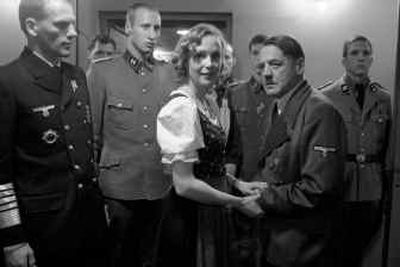”Downfall” is well-made, but it lacks a fresh angle

Germany has tried for 60 years to define itself by what it isn’t.
Germany’s eagerness to shun its Nazi past has had costs. There have been limits on free speech and free association. There’s also been a sort of willful amnesia. Until now.
“Downfall” is the first German film to feature the Nazi villain since G.W. Pabst’s “The Last Act” in 1956. Set during the last days of the “thousand-year Reich,” “Downfall” unfolds as the Russian infantry is approaching Berlin.
Hitler and his cronies are huddled in their bunker, their world clearly crashing down around them. But Hitler – madder and more self-deceiving than ever – can’t face that fact for more than a few moments. At one point, he’s handing out cyanide capsules to his trusted aides. At another, he’s confidently planning his counterattack – with divisions that no longer exist.
A Best Foreign-Language Film hopeful at this year’s Oscars, “Downfall” captures what it must feel like to live in a city under siege, with lawlessness and vigilantism in the streets and constant, anonymous terrorism. (You never see an Allied soldier until the film’s final minutes.) But mostly it’s set in the bunker, where Hitler and his madmen plot.
As Hitler, the great Bruno Ganz – veteran of films including “Wings of Desire,” Herzog’s “Nosferatu” and last year’s “The Manchurian Candidate” – gives a superb performance. He grows more stooped with every day. His hand shakes uncontrollably. But the fire still burns, and he is capable of going from fussing over his dog to railing against the Jews in seconds.
He’s well supported, too, by Ulrich Matthes – spookily on target as the death’s-head Goebbels – and Corinna Harfouch as Goebbels’ even more horrifying frau. (Unwilling to raise her children “in a world without National Socialism,” she tenderly poisons them in their beds.)
Alexandra Maria Lara is less effective as Traudl Junge, Hitler’s last secretary, perhaps because her story’s been told before, perhaps because her feelings remain unclear. Sometimes unclear as well is the movie’s huge cast of characters; it can be hard to remember which Nazi is which, and the pace can be sluggish.
All in all, this is a well-made film, but not particularly fresh for audiences in America, where other films have focused on the Reich’s last days. But it is new for Germans. And it opens up the idea of defining themselves not only by what they are, but by what – amazingly, horrifying, inexplicably – they were.